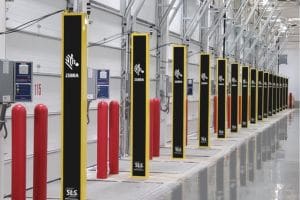Start Your RFID Technology Adoption with a Pilot Project
For warehouse and manufacturing professionals considering the adoption of RFID (Radio Frequency Identification) technology , the move promises significant gains in visibility, accuracy, and efficiency. However, jumping into a full-scale RFID deployment without first testing the waters can lead to unforeseen costs and complications. That’s why a strategically scoped RFID pilot project is often the smartest first step. A well-executed pilot provides invaluable insights and reduces risk, while setting the stage for scalable, long-term success of your RFID application.
Why Start with an RFID Pilot Project?
In his book Good to Great, the best-selling business author Jim Collins discusses the concept of “BB’s, then bullets, then cannonballs.” He explains how great business decision makers don’t make significant business investments without first testing the waters, progressively enlarging the funding as the benefits are proven. This is a tremendous analogy to use when thinking about RFID, which can require significant investments for complete adoption, but can often be tested relatively inexpensively in pilot projects.
RFID is a powerful technology, but it is an engineered rather than a plug-and-play solution. Warehouses vary widely in layout, materials, workflows, and operating conditions—all of which affect how an RFID solution performs in a real-world environment.
Starting with an RFID pilot project allows your team to:
- Evaluate RFID performance in your actual environment (metal surfaces, high traffic, etc.).
- Validate hardware and tag choices before bulk investment.
- Identify integration needs with your warehouse management system (WMS) or ERP.
- Measure ROI potential based on real operational metrics.
- Gain internal buy-in for the RFID project from users and decision-makers based on data and experience.
Most importantly, your organization can discover all of the things which you hadn’t considered or hadn’t anticipated when establishing your RFID project goals!
With these insights, organizations can design a next-phase RFID rollout that’s technically sound, financially justified, and fully aligned with business goals.

RFID Challenges Solved During a Pilot
Even in well-planned deployments, implementing an RFID solution can present challenges. A pilot project offers the ideal proving ground to address the following issues:
- Tag Selection and Placement
RFID tag performance varies by material, size, and placement. During the pilot, you can test different tag types to see which work best for your inventory—especially items with challenging surfaces like metal or liquids. Will you purchase pre-printed tags, or use RFID printers to generate and encode tags on demand? - Read Range and Reader Placement
RFID signals behave differently depending on interference, reader power, and physical layout. A pilot helps determine optimal RFID reader positions, antenna orientations, and read zones. - Data Filtering and Management
RFID generates a lot of data. A pilot helps identify the right logic and filters to capture only meaningful, actionable information. - System Integration
Connecting RFID data to your existing WMS or ERP requires configuration and sometimes customization. A pilot identifies integration needs early, so you avoid surprises during full deployment. - Staff Training and Process Alignment
A pilot project offers a low-risk opportunity to educate staff, gather feedback, and fine-tune workflows before broader adoption. Ensure your whole team, and not just the information technology department, is ready for the RFID implementation.

Warehouse Workflows That Are Ideal for RFID Pilots
To get the most from a pilot, start with workflows that are high-impact, easy to measure, and frequently performed. Some of the best areas for RFID pilot projects include:
1. Inbound Receiving
- Automate the verification of received goods against purchase orders.
- Quickly identify shortages or mismatches.
- Reduce manual scanning or counting at the dock.
2. Asset Tracking
- Monitor high-value tools, pallets, or returnable containers with RFID tagging.
- Ensure assets are available when needed and not lost or misplaced.
- Great for maintenance-heavy environments where equipment moves often.
3. Inventory Management and Cycle Counting
- Replace manual or barcode-based cycle counts with hands-free RFID sweeps.
- Increase count frequency without increasing labor.
- Reduce shrinkage and improve inventory accuracy.
4. Work-in-Process (WIP) RFID Tracking
- Track parts or assemblies through multi-stage production.
- Identify bottlenecks or delays in real time.
- Ensure traceability and quality assurance for complex builds.
5. Shipping Verification
- Validate that the correct items are loaded onto outbound shipments.
- Prevent costly shipping errors or misdeliveries.
- Improve customer satisfaction and reduce return handling.

An RFID Pilot is a Smart Way to Start
RFID has the potential to transform warehouse and manufacturing operations, but achieving a successful deployment requires more than just installing readers and slapping on tags. Success goes far beyond simply purchasing RFID equipment. A pilot project provides a structured way to test, learn, and refine—allowing your team to understand the technology, mitigate risks, and build a solid case for broader investment.
By starting small and scaling smart, warehouse and manufacturing organizations can set the foundation for RFID success that delivers measurable value across the operation.
Let’s Discuss Your RFID Pilot
The RFID team at CSSI Technologies is ready to discuss your business processes and benefits of RFID. Get ready to implement RFID with confidence and attain a successful RFID investment. We can help you identify the best workflow to target with an RFID Pilot. Please contact us to discuss your RFID questions today.
